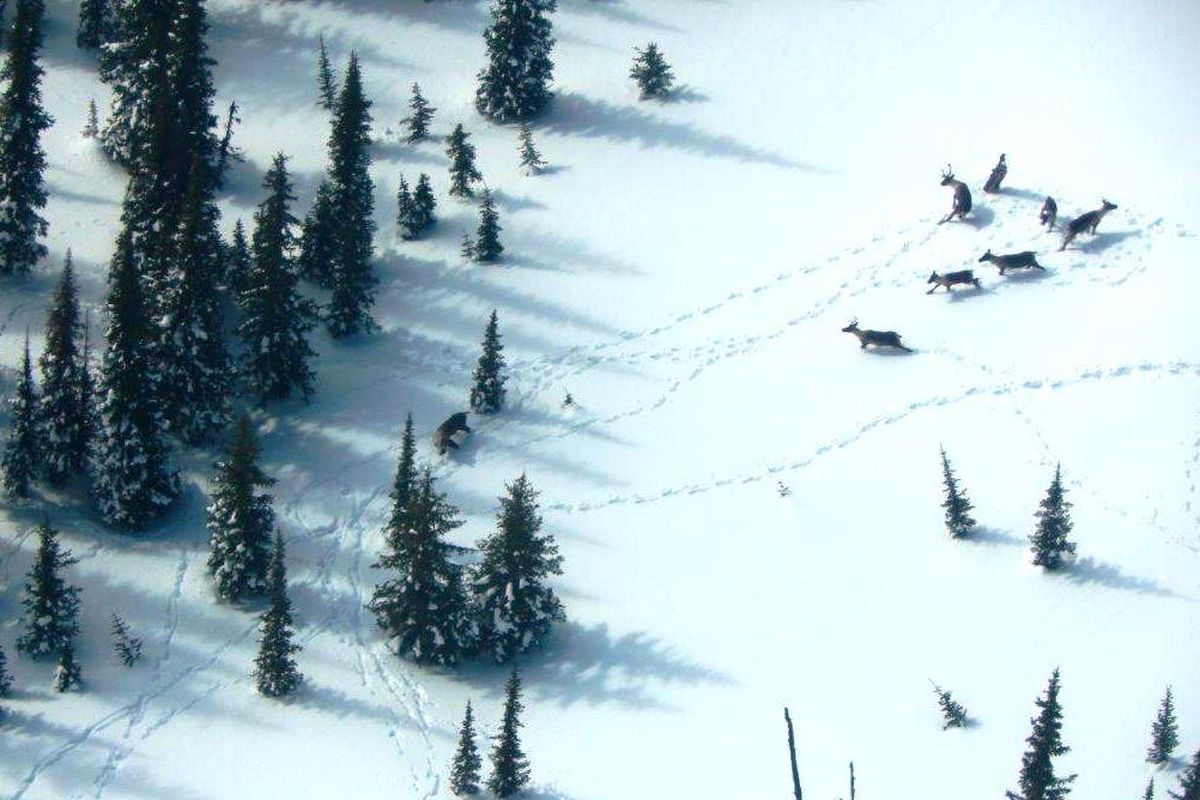Volunteers gather lichen to help save critically endangered mountain caribou

Volunteers in North Idaho are lichen their role in saving the most critically endangered animals in North America.
In a last-ditch effort to keep the dozen or so South Selkirks mountain caribou from extinction, the Kalispel Tribe is joining several other groups, agencies and tribes to capture pregnant cows next spring and let them calve in the security of a 19-acre enclosure.
The herd of so few could be doomed if predators zero in on them during the vulnerable calving period, said Bart George, wildlife biologist for the Kalispel Tribe.
The south herd ranges through the high country along the crest of the Selkirks near the international border. The caribou have oversize hooves allowing them to walk on the snow. As the snowpack increases, it elevates caribou to feed on lichen higher in trees.
The maternal pen project, a technique that’s succeeded farther north in Canada, seeks to protect the caribou from the teeth of cougars, bears and wolves until the calves are stronger, more mobile and more likely to survive.
The pregnant cows will need to be fed their normal winter diet of arboreal lichen that hangs from tree limbs. They’ll be fed the lichen for seven to 10 days until the contained caribou can be gradually eased onto a diet of pelletized food that’s fed to reindeer, George said.
“We’ll need about 250 pounds of lichen,” George said. “That doesn’t sound like much, but you can’t buy it, and it takes a lot of lichen to make a pound.”
The Selkirk Conservation Alliance is organizing volunteers to collect lichen mostly in the Priest Lake area this winter.
“There’s more to it that you might think,” said Cheryl Moody, SCA executive director.
Obtaining a group permit from the Idaho Panhandle National Forests for gathering the large volume of lichen took five months, she said.
A dozen volunteers working off and on since June have collected many large bags of lichen, but the total dried weight is only about 100 pounds.
“We have a ways to go,” she said.
“We need to be ready for seven or so pregnant cows. That’s 38 pounds of lichen per cow, or 266 pounds.”
One volunteer has donated a large shop for drying the lichen to prevent mold after volunteers drop it off at the SCA office in Priest Lake, Moody said.
“We clean it and hang it in the bags used to store soccer balls,” she said.
More volunteers are needed through the winter before caribou are captured in spring, she said.
“Volunteers need to check in with us to be under our umbrella permit for gathering lichen in the Priest Lake area,” she said. “I’m happy to talk to groups or meet with them as they go out for their first collection.”
Since low-hanging lichen has already been eaten by deer and elk, collectors need an extendable pole to reach up 10 feet or more. Long hiking poles or avalanche probes would work, she said.
“You figure out the technique over time, but expect to get a lot of water and snow in your face.”
The Kalispels already have committed about $200,000 to the effort, said Ray Entz, project leader.
“We built the maternal pen in Canada at 6,000 feet,” George said. “It’s a big job to enclose 19 acres in the mountains with 15-foot-high solid fencing. Then we had to set up a camper trailer and build a lean-to structure over it strong enough to withstand 10 feet of snow.”
A “shepherd” will be stationed at the trailer to maintain the fence from blowdown trees.
Biologists will shoot nets from helicopters to catch at least six pregnant cows, probably in March, and hold them through calving for about three months, George said. The caribou will be radio-collared before release.
The caribou are threatened by a range of habitat and other factors, including vehicle collisions on Highway 3 in British Columbia near Kootenay Pass.
Cougars and bears take a toll on the caribou, but the recovery of wolves in the region tipped the balance dramatically.
“The number of caribou plummeted after wolves recolonized the area starting in 2009,” George said.
Canadian wildlife agencies have removed about 20 wolves over four years to reduce the predator impact on the South Selkirk caribou, he said. Three packs in the herd’s range are staying at lower elevations and leaving the caribou alone at this time, he said.
The U.S. Fish and Wildlife Service wrote its first recovery plan for mountain caribou in the early 1980s and it was reworked in 1994. Working with Canadian agencies and First Nations, caribou from other regions were trapped and released in the area with some positive results.
“The population was on an upward trajectory until 2009 when one more predator was added to the mix,” George said.
The Kalispel Tribe has stepped up to join another effort to revive the caribou because the species is important to their cultural history, Entz said.